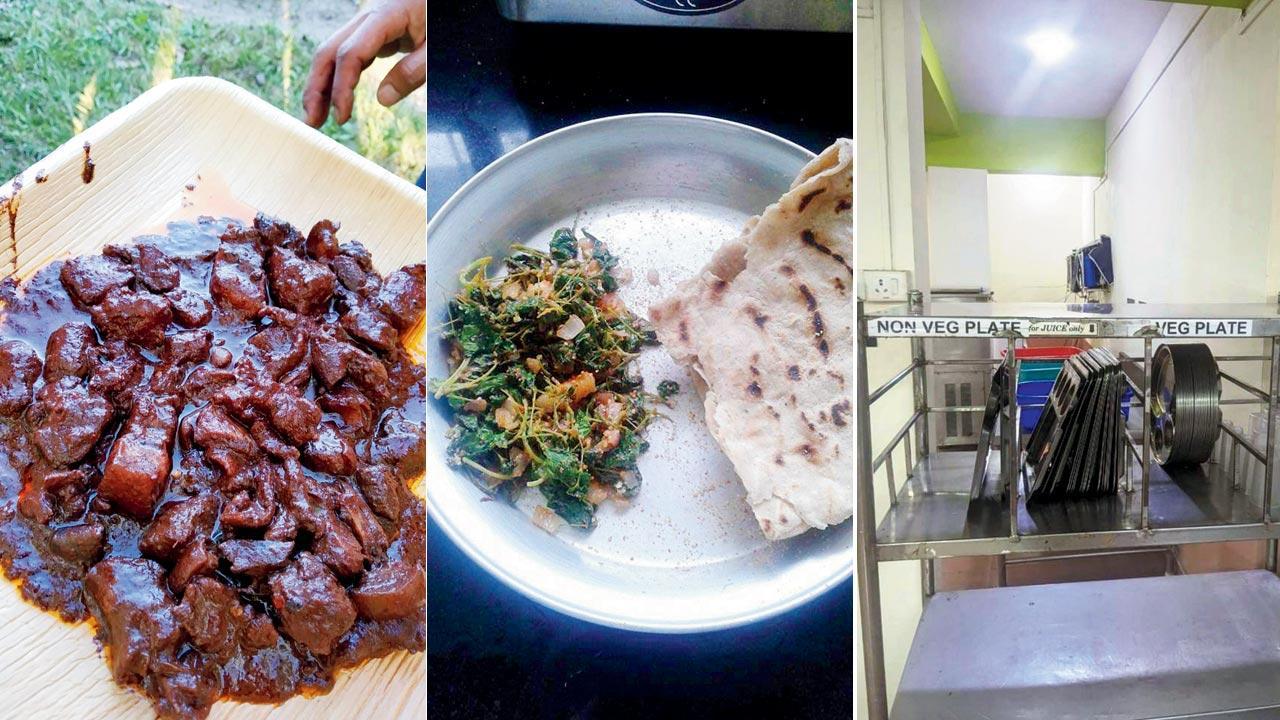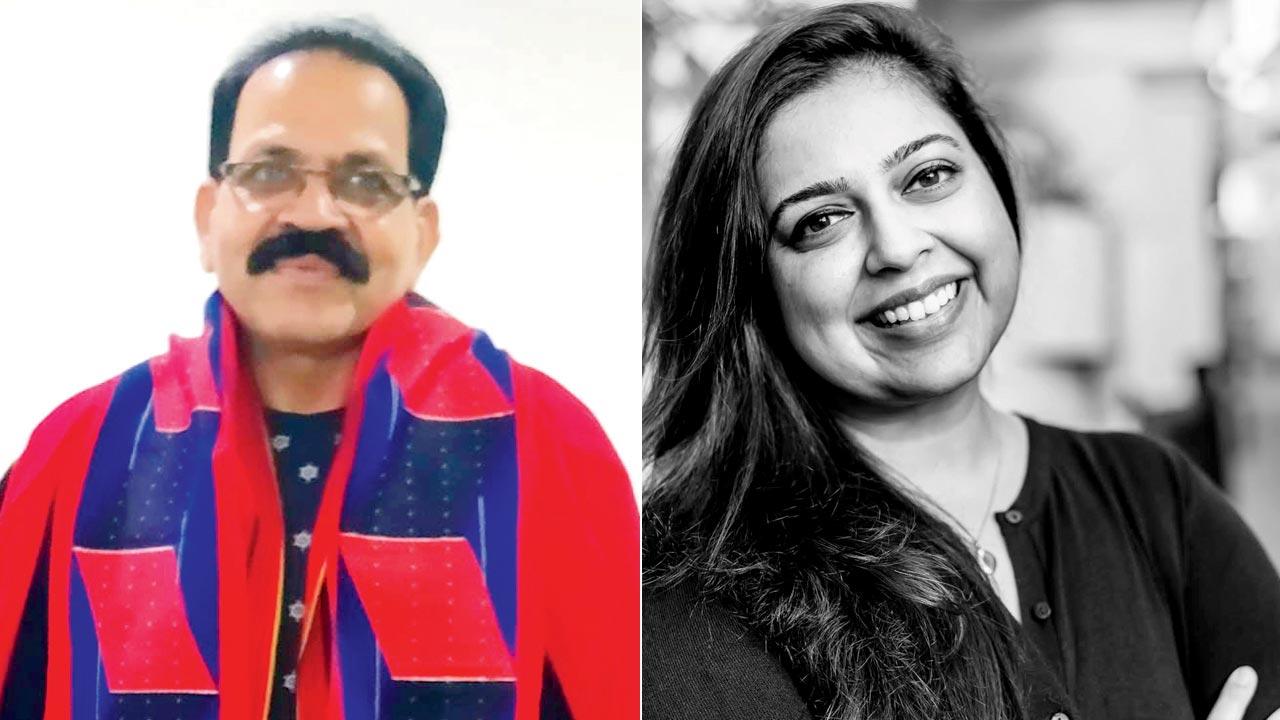Communal tables are a fad only in Michelin star restaurants. In India’s top educational institutions, marginalised continue to be reminded about the “dirty picture” of their culinary choices

Rakti or goat bloody fry uses coagulated blood, diced onions and simple spices to rustle up a protein-rich eat; Foraging is a big part of Dalit food practices. Seen here is jowar bhakri and tarwat which are leaves of a leguminous tree; The plates rack at IIT Delhi stacks rectangular plates for non-vegetarian students and round thalis for vegetarians. Pics Courtesy/Shahu Patole
The mess at the IIT-Bombay campus in Powai houses two varieties of plates, the round steel thali and a rectangle one. The round is picked up by vegetarians. If in a moment of ignorance, you, the non-veg eater picks up the round plate, you don’t say, “Oops!” and place it back on the rack. You deposit it straight into the wash basin area. It will be cleaned before it once again reaches the next vegetarian student on campus. It’s not earmarked in any rulebook. But it is a rule, unsaid and immovable.
The marginalised students belonging to Scheduled Castes and Tribes (SC, ST), and Other Backward Castes (OBC) know that they must eat off the rectangular thali, even if by choice they have adopted a plant-based diet. Years of conditioning and having to manoeuver the relationship between caste and food
makes them informed.
Last week, sparks flew when “Vegetarians only” posters appeared on the walls of a dining hall of hostel 12 IIT-B, with students claiming that it was the vulgar display of discrimination and had no institutional backing. According to the Ambedkar Periyar Phule Study Circle (APPSC), correspondence from the general secretary had stated that while there was a separate counter to serve vegetarian food, there was no rule about eating it and where.
 Shahu Patole and Ragini Kashyap
Shahu Patole and Ragini Kashyap
“It’s always been this way,” an IIT-B student pursuing a PhD and a member of the APPSC, shrugs. “Food is a tool of segregation and hierarchy even at a prestigious institute such as this. Food helps the upper caste identify us, and then, isolate.” While initially agreeing to speak to mid-day for this article, the student had a change of heart after fearing disciplinary action. The institute, he says, has got him to sign a bond that prohibits him from speaking to the media or “tarnish the reputation” of the college.
At a time in India, when food is so much more than sustenance; home chefs are gaining respect, culinary startups are raking in the moolah and everyone with a phone is on Swiggy and Zomato, you’d imagine that “dirty” is not a term that would be associated with it.
A YouTube channel that has been gaining popularity is one that follows the cooking, methods and recipes of the Dhangar community, the herding and shepherd caste of Western Maharashtra and Marathwada. While the Marathi diaspora, including Brahmin Internet users, could be viewing the episodes, it’s unlikely that they will agree to actively engage with the food and its people in person, says Bhushan Korgaonkar, theatre writer-producer-director, who has been working with Lavani artistes and enjoys writing on food.
Author and former journalist Shahu Patole is said to have written one of the most important books on Dalit food. In a conversation with this writer, Aurangabad-based Patole clarifies that it’s a myth that the marginalised eat only meat, or more of it. “For most of us in rural Maharashtra, meals were about foraging vegetables that grew close to us,” says Patole, who grew up in Khamgaon, “One kilo of mutton costs Rs 750; a Dalit home can afford this once every few weeks.” Negotiating this control of access to food saw the lower castes find ingenious, cheap ways to get their protein fix, including waiting for the butcher to slaughter a goat in order to collect the fresh blood that they’d turn into Lakuti. In Tamil Nadu, it’s called mutton ratha poriyal or goat blood fry. Wajadi, another Marathi Dalit dish, is made by rubbing the animal’s intestinal skin, cleaning the offal and flavouring it with basic masala.
The discarded parts of the animal, whether coagulated blood or intestinal skin, was what was left to work with. Chefs today will call it experimentation or working with kitchen waste; they called it survival.
Because the Brahmins shunned beef, it was economically and easily available to the lesser privileged. So, when you ban beef, calling it a sin, you take away the only option available to the oppressed; an option that wasn’t a choice in the first place but a fallout of lack of options. Patole’s 2016 book, Anna He Purna Brahama, has a title that plays cheekily on a phrase that the upper caste recites before the start of a meal. It chronicles recipes from both, the Mang (Dalit sub-caste) and Mahar community (distinguished as mrutaharis or those who eat dead animals), both belonging to the Scheduled Caste. It’s important because India’s culinary history has largely overlooked lower caste food practices.
He says that his experience has been that cultural hegemony using food has got more aggressive in schools, colleges, and offices, in recent years. “Food has always been used to show the marginalised their place by both the upper castes and classes. Now, though, it is in your face, and the current political dispensation isn’t helping control the behaviour. It has little to do with plant or meat-based food. And more about status quo.”
He offers a curiously interesting anecdotal observation when he says that a Hindu from the upper castes in Western Maharashtra might come to terms with taking a bite from a Muslim person’s plate or tiffin, but will hesitate to when approached by a Dalit. “Western Maharashtra has a strong Muslim royalty legacy,” he says, referring to the Khiljis, Tughlaq and Mughal dynasties. “There is a feeling of kinship,” he thinks. His daughter, a student at Oxford, recounting a recent instance of
being asked by a prospective Hindu landlord in London about her caste has him wonder if migrating to the West is an escape after all.
Bengaluru-based food historian Ragini Kashyap has studied the impact of caste oppression on food. “The Indian Diaspora in the US and UK is extremely invested in keeping the power dynamics alive,” she says.
In an academic paper dated 2021, Kashyap writes how caste in ingrained in our taste buds. “That you might not want to eat meat is your choice, but when you other someone who eats it and then use it to establish supremacy, there lies the problem.” The irony doesn’t miss her, she says, when she sees a religion that was born as a reaction against the Brahmanical caste system, Jainism, and its followers create social compartments based on what we eat. “During the COVID lockdown, I remember reading an article which mentioned a sign outside a gurudwara that read, ‘Food available for everyone. All castes served’.” She says that at the core of Sikhism was the desire to establish equality and revolt against the divisiveness of the caste system.
“But caste continues to persist there as well.”
Back in IIT-B, our Ph D student friends tells us that the class WhatsApp group often sees pseudo-science articles shared that espouse the merits of vegetarianism and how it is environment-friendly. “Caste assertion is more subtle in the classroom. The push for vegetarianism comes with insight on health benefits or how culling animals for consumption can disrupt the natural food chain. But the messaging is frequent and constant. As we navigate the day from breakfast to bed time, we seem to be receiving the signs that we are doing is wrong,” says the student.
IIT Bombay spokesperson in a statement to mid-day said, "IIT Bombay is an 'Institute of Eminence'. Students and faculty from across the globe and varied cultural backgrounds come to IIT Bombay as the Institute boasts of an inclusive and assimilating culture. We wish to assert that we do not have any such policy on separate plates in our hostels for veg/non-veg. All plates are common for all students. The Institute has zero tolerance policy for any form of discrimination."
Rs 750
What one kilo of mutton costs. A Dalit home can afford this once every few weeks
 Subscribe today by clicking the link and stay updated with the latest news!" Click here!
Subscribe today by clicking the link and stay updated with the latest news!" Click here!










